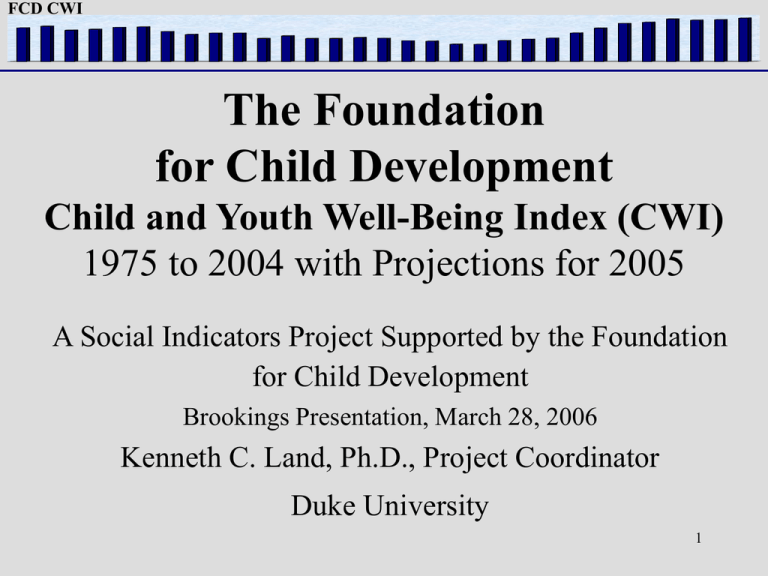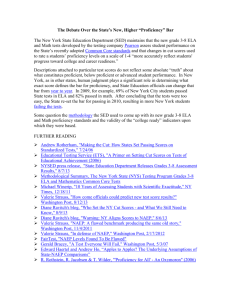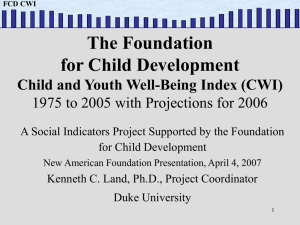FCD CWI
advertisement

FCD CWI The Foundation for Child Development Child and Youth Well-Being Index (CWI) 1975 to 2004 with Projections for 2005 A Social Indicators Project Supported by the Foundation for Child Development Brookings Presentation, March 28, 2006 Kenneth C. Land, Ph.D., Project Coordinator Duke University 1 FCD CWI What is the CWI? • A composite measure of trends over time in the quality of life, or well-being, of America’s children and young people. • It consists of several interrelated summary indices of annual time series of 28 social indicators of well-being. 2 FCD CWI The Objective of the CWI: • To give a sense of the overall direction of change in the well-being of children and youth in the United States as compared to 1975. 3 FCD CWI The CWI is designed to address the following types of questions: • Overall, on average, how did child and youth well-being in the United States change in the last quarter of the 20th century and into the present? • Did it improve or deteriorate, and by how much? • In which domains or areas of social life? 4 FCD CWI • • • • For specific age groups? For particular race/ethnic groups? For each of the sexes? And did race/ethnic group and sex disparities increase or decrease? 5 FCD CWI Methods of Index Construction • Annual time series data (from vital statistics and sample surveys) have been assembled on some 28 national level indicators in seven quality-of-life domains. – – – – – – – Family Economic Well-Being Health Safety/Behavioral Concerns Educational Attainment Community Connectedness Social Relationships (with Family and Peers) Emotional/Spiritual Well-Being 6 FCD CWI • These seven domains have been wellestablished in over two decades of empirical studies of subjective well-being by social psychologists and other social scientists. • In this sense, the CWI is an evidence-based measure of trends in averages of the social conditions encountered by children and youths in the United States. 7 FCD CWI • Each of the 28 Key Indicators is indexed by percentage change from the base year, 1975. – That is, subsequent annual observations are computed as percentages of the base year. – Three indicators begin in the mid-1980s and use corresponding base years. • The base year is assigned a value of 100. – The directions of the indicator values are oriented such that a value greater (lesser) than 100 in subsequent years means the social condition measured has improved (deteriorated). 8 FCD CWI • The time series of the 28 indicators are grouped together into the seven domains described above and domain-specific summary well-being indices are constructed. – Within these summary indices, each indicator is equally weighted. • The seven component indices are then combined into an equally-weighted summary index of child and youth well-being. 9 FCD CWI Significant Findings • The following charts show changes over time in the CWI and its various components. – Overall Index of Child Well-Being – Domain Specific Index: Educational Attainment • Math Scores • Reading Scores – Effects of Demographic Standardization 10 FCD CWI Figure 1: Child and Youth Well-Being Index (CWI), 1975-2004, with Projections for 2005 110 100 95 90 Year 20 05 20 03 20 01 19 99 19 97 19 95 19 93 19 91 19 89 19 87 19 85 19 83 19 81 19 79 19 77 85 19 75 Percent of Base Year 105 11 FCD CWI Figure 2. Domain-Specific Summary Indices, 1975-2004, with Projections for 2005. 160 Family Economic Well-Being Health Safety/Behavioral Concerns Educational Attainment Community Connectedness Social Relationships Emotional/Spiritual Well-Being 150 140 120 110 100 90 80 70 Year 20 05 20 03 20 01 19 99 19 97 19 95 19 93 19 91 19 89 19 87 19 85 19 83 19 81 19 79 19 77 60 19 75 Percent of Base Year 130 12 FCD CWI Focus: Educational Attainment Measures • NAEP: National Assessment of Educational Progress -- the “Nation’s Report Card” – Supervised by the National Assessment Governing Board. – Periodic assessment of student knowledge and abilities in a number of subjects. – NAEP long-term trend assessments in Math and Reading use the same testing instruments and procedures to replicate test results over time for children aged 9, 13, and 17. 13 FCD CWI Figure 3. NAEP Math Scores, 1978-2004 320 300 260 Age 17 Age 13 240 Age 9 220 Year 20 05 20 03 20 01 19 99 19 97 19 95 19 93 19 91 19 89 19 87 19 85 19 83 19 81 19 79 200 19 77 NAEP Math Score 280 14 FCD CWI Figure 4. NAEP Reading Scores, 1975-2004 320 300 260 Age 17 240 Age 13 Age 9 220 Year 20 04 20 02 20 00 19 98 19 96 19 94 19 92 19 90 19 88 19 86 19 84 19 82 19 80 19 78 19 76 200 19 74 NAEP Reading Score 280 15 FCD CWI The Interrelationship of Trends in Education and Educational Attainment • Are pre-Kindergarten enrollment rates leading indicators for Age-9 test scores? 16 FCD CWI 250 56 245 49 240 42 235 35 230 28 225 Percent of Children, Ages 3-4, in Pre-Kindergarten NAEP Math Scores, Age 9 21 220 NAEP Reading Scores, Age 9 Year 20 04 20 03 20 02 20 01 20 00 19 99 19 98 19 97 19 96 205 19 95 0 19 94 210 19 93 7 19 92 215 19 91 14 17 NAEP Score 63 19 90 Percent in Pre-Kindergarten Figure 5. Percent Enrolled in Pre-Kindergarten, Ages 3-4 and NAEP Mathematics and Reading Scores, Age 9, 1990-2004 FCD CWI Demographic Standardization • A technique for examining how a trend might be affected if the characteristics of the students had not changed over time: – For example, what would the math trend be if the race/ethnic composition of schools had remained the same as in 1978? • Thus, standardization controls for the effects of compositional changes on overall rates. 18 FCD CWI The Impacts of Changes in Student Composition since the 1970s on NAEP Test Scores Two significant changes are studied here: 1. Changes in the racial and ethnic composition of U.S. students. 19 FCD CWI Figure 6. Changing Racial/Ethnic Distribution of NAEP Students Age 17, 1978-2004 90 80 70 White Black Hispanic Other 50 40 30 20 10 Year 05 20 03 20 01 20 99 19 97 19 95 19 93 19 91 19 89 19 87 19 85 19 83 19 81 19 79 19 77 0 19 Percent 60 20 FCD CWI The Impacts of Changes in Student Composition since the 1970s on NAEP Test Scores Two significant changes are studied here: 1. Changes in the racial and ethnic composition of U.S. students. 2. Changes in parents’ level of educational attainment. 21 FCD CWI Figure 7. Changing Distribution of Parents' Highest Level of Education for NAEP Students Age 17, 1978-2004 60 College graduate HS graduate 50 Post HS education Less than HS diploma 30 20 10 Year 20 05 20 03 20 01 19 99 19 97 19 95 19 93 19 91 19 89 19 87 19 85 19 83 19 81 19 79 0 19 77 Percent of students 40 22 FCD CWI Figure 8. NAEP Math Scores, Age 17: As Reported and Standardized to 1978 and 2004 Racial/Ethnic Distributions 312 310 306 304 302 Standardized to 1978 Racial/Ethnic Distribution 300 Reported NAEP Math Scores 298 Standardized to 2004 Racial/Ethnic Distribution Year 20 05 20 03 20 01 19 99 19 97 19 95 19 93 19 91 19 89 19 87 19 85 19 83 19 81 19 79 296 19 77 NAEP Math Score 308 23 FCD CWI Figure 9. NAEP Math Scores, Age 17: As Reported and Standardized to 1978 and 2004 Parents' Highest Level of Education 312 310 306 304 302 Standardized to 2004 Parental Education Levels 300 Reported NAEP Math Score 298 Standardized to 1978 Parental Education Levels Year 20 05 20 03 20 01 19 99 19 97 19 95 19 93 19 91 19 89 19 87 19 85 19 83 19 81 19 79 296 19 77 NAEP Math Score 308 24 FCD CWI Figure 10. NAEP Reading Scores, Age 17: As Reported and Standardized to 1980 and 2004 Racial/Ethnic Distribution 293 291 287 285 283 Standardized to 1980 Racial/Ethnic Distribution Reported NAEP Reading Scores 281 Standardized to 2004 Racial/Ethnic Distribution Year 20 05 20 03 20 01 19 99 19 97 19 95 19 93 19 91 19 89 19 87 19 85 19 83 19 81 279 19 79 NAEP Reading Score 289 25 FCD CWI Figure 11. NAEP Reading Scores, Age 17: As Reported and Standardized to 1980 and 2004 Parents' Highest Level of Education 293 291 287 285 283 Standardized to 2004 Parental Education Levels Reported NAEP Reading Scores 281 Standardized to 1980 Parental Education Levels Year 20 05 20 03 20 01 19 99 19 97 19 95 19 93 19 91 19 89 19 87 19 85 19 83 19 81 279 19 79 NAEP Reading Score 289 26 FCD CWI Conclusions • The overall well-being of children and youth in the United States showed substantial improvement for the ten years from 1994 to 2003. – These improvements continued at a slow pace in 2004, and likely continued through 2005. • Historically, however, the CWI showed a decline in well-being for a number of years in the 1980s and reached low points in 1993 and 1994. – These declines mirror economic restructuring, recessions, and demographic changes. • Only since the year 2000 has the CWI improved to above 1975 levels. 27 FCD CWI Conclusions (cont.) • The Key Indicators in the Educational Attainment Domain have shown only slight changes since the mid-1970s: – Math Scores: • Slight improvement at all ages – Reading Scores: • Some improvement for age 9 • Little change for age 13 • Decline for age 17 28 FCD CWI Pre-Kindergarten Enrollment Rates and Test Scores • There was a positive relationship between increases in pre-Kindergarten enrollment rates in the 1990s and increases in age-9 NAEP mathematics and reading scores in the early-2000s. • This suggests that increases in pre-K enrollment rates at ages 3 to 4 were leading indicators of the increase in the test scores for 9-year olds a few years later. 29 FCD CWI Effects of the Changing Mix of Students • Our demographic standardization analyses show: Improvements in parents’ education have had positive effects on student math scores. The changing racial/ethnic distribution of students has had a smaller effect on test scores. There has been a general downturn in age 17 reading test scores since 1992; the downturn would have been larger without increases in parental education levels over the past three decades. 30 FCD CWI Implications • If the positive association of preKindergarten enrollments and age-9 NAEP test scores continues to hold, it can be anticipated that further increases in pre-K enrollments will result (with a 5 to 6 year lag) in continued improvements in the age-9 test scores. 31 FCD CWI Implications, Cont. • Improvements in parental educational attainments are partially transferred to the abilities of their children in mathematics and reading; this is consistent with over four decades of research on intergenerational socioeconomic status transfers. • The increases in rates of college graduation of young adults in the 1990s should lead to higher math test scores as they rear children over the next decade. • Increases in education levels for minority parents should reduce race/ethnic disparities in future test scores. 32 FCD CWI Implications, Cont. • Further research on the downturn in reading test scores for 17-year olds is required to explain the declines over the past decade. – For instance, we do not know the extent to which the decline is related to the widespread use of new media for entertainment (e.g., video games, the Internet) and corresponding declines in time devoted to reading and the extent to which such changes are reversible. 33 FCD CWI The CWI on the Web: http://www.soc.duke.edu/~cwi/ 34




